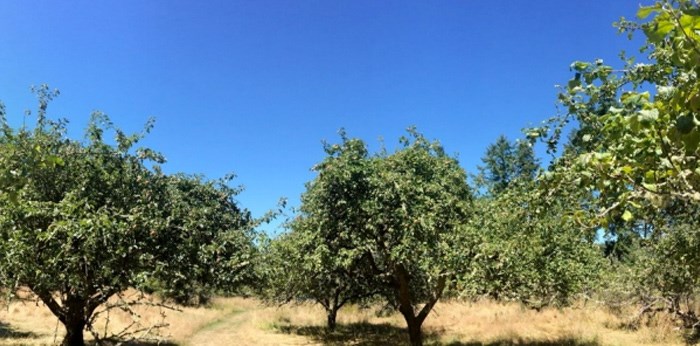 An apple orchard in the Gulf Islands National Park Reserve. The orchards offer a glimpse into the lives of settlers who came to the region as early as the 1870s. Photograph By Parks Canada
An apple orchard in the Gulf Islands National Park Reserve. The orchards offer a glimpse into the lives of settlers who came to the region as early as the 1870s. Photograph By Parks Canada
Dozens of varieties of heritage apples, fruits and nuts from orchards in the Gulf Islands National Park Reserve are now available for visitors to pick for free.
Apples that aren’t found in grocery stores — such as Fameuse and King of Tompkins County — can be picked in the park reserve, along with old favourites such as Golden Delicious and Red Delicious, said Laura Judson from Parks Canada.
“There is incredible history behind the apple orchards in the park reserve,” said Judson, adding public picking opportunities are rare in the region.
But don’t expect to pick a bushel of fruit — there is a limit of six pieces of fruit, per type and per person, each visit. Ladders, climbing and anything that might damage the trees is not allowed.
Over the past decade, Parks Canada has worked to identify and restore 17 abandoned orchards on eight islands, some of which are accessible by ferry and others only by private boat. Horticulture students from Camosun College have helped prune and restore the trees.
With the help of archeologists, cultural workers and fruit testers, 24 varieties of apples were identified.
There are 137 fruit trees on the islands, which include apples, pears, cherries, plums, quince and nuts.
Some apples were grown to be shipped to Barkerville during the Cariboo gold rush in the 19th century, while other varieties came from places such as Quebec, Indiana and New York, Judson said.
“Settlers likely brought these varieties with them from their homes when they travelled to the Gulf Islands. In fact, while the Okanagan is now the centre of B.C.’s fruit industry, the Gulf Islands used to be the largest apple-producing region in the province.”
Much of the historical information has come from land-use documents.
Laura Peterson, a cultural-resource manager who has worked on the orchard project for a number of years, said the heritage fruit trees offer a glimpse into the lives of settlers who came to the region as early as the 1870s, “and help us understand how these orchards tied into the local and provincial economy.”
Parks Canada has created a map of all the orchards, highlighting six that are the most accessible, with the most trees and interesting information available.
These include the largest orchard, at James Bay on Prevost Island, which was established in 1889 and has 23 trees with three varieties of apples: the Wealthy and King of Tompkins County from the U.S. and the Antonovka from Russia.
Peterson said members of the local B.C. Fruit Testers Association helped to identify the different varieties.
“They look for different clues and need a ripe fruit in fairly good condition. They might also need leaves and the stem,” she said.
Testers will consider the look and taste of the fruit as well as how it keeps. “There’s a strong knowledge base there. They’ve been doing this for a while.”
There are two orchards on North Pender Island. One, called Roesland, was planted by Scottish settlers in 1908. The other, at Shingle Bay, is one of the newer orchards, established between 1950 and 1975, with Red Delicious, Golden Delicious and Red Spartan apples.
Two of the orchards were planted by Hawaiian settlers in the late 1800s.
The Palau orchard at Princess Bay on Portland Island has 31 trees and seven heritage apple varieties, including the Newton Wonder, Lemon Pippin, Red Delicious, Northwest Greening, Winter Banana, Rome Beauty and what is likely the Yellow Bellflower.
The Mahoi orchard on Russell Island has three apple varieties, as well as a cherry orchard and fruit garden that helped sustain the Mahoi family for generations.
The orchard at Narvaez Bay on Saturna Island was also part of a family homestead that was planted in the 1920s and then sold in 1944.
Peterson said there were not as many apples this year, possibly due to weather, but fruit will likely remain on the trees until late October.
Read more from the Times Colonist


